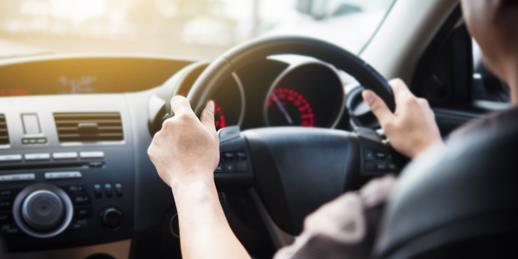
Extreme heat is still relatively new for us in the UK, but it can negatively impact vehicles, drivers and passengers when temperatures soar.
Here are some tips to help you stay safe and enjoy driving – even in the hottest summer sunshine.
EASY AS HACK
Hot weather can increase the chances of a tyre blowout. The correct tyre pressure for your vehicle can often be found printed either on the sill of the driver’s door or inside the fuel tank flap.
At a glance
- Extreme heat can increase the chances of vehicle breakdown
- Summer sunshine brings health hazards for drivers and passengers
- What you can do to protect yourself and your vehicle from extreme heat
CHECK THE VEHICLE COOLING SYSTEM
When temperatures rise, the main concern is the possibility of your vehicle overheating. Depending on how old your car is, there will either be a temperature gauge or warning light to alert you that it is too hot – but it’s much better to take proactive action to avoid this.
The critical step is to have your vehicle’s cooling system checked – if it’s leaking or the cooling fan isn’t working, that could cause overheating and engine damage.[1] Check that there’s enough coolant to prevent the liquid in your car’s radiator system from overheating by locating the minimum and maximum markers on the coolant tank.
If your car does require a top-up, only do this when you have turned the engine off for a while. Uncapping the coolant tank when the engine is warm can spray hot liquid everywhere.[2]
KEEP TYRES AT THE CORRECT PRESSURE
Hot weather can increase the chances of a tyre blowout because summertime sunshine increases pressure, which causes the air inside your tyres to expand. So, it’s essential to maintain all your tyres at the correct pressure for your vehicle.
If you can’t find your vehicle handbook, the correct tyre pressure for your vehicle can often be found printed either on the sill of the driver’s door or inside the fuel tank flap.
If your tyres have changed from the original tyres the recommended pressure may be different than what's recommended in your log book, on the sill of the driver's door or inside the fuel tank flap.
Read next: What tyres do I need?
Should the worst happen and you have a flat tyre, the RAC has helpful guides explaining how to fit a spare wheel or use a tyre repair kit.[3]
CHECK YOUR ROUTE
It’s worth double checking your journey to avoid delays where possible. Apps such as Google Maps, Waze are a great way to check for any updates before you set off, as nobody wants to be stuck in traffic in the heat.
WATCH YOUR WINDSCREEN
Extreme heat can make the glass of your windscreen expand, which will stress any existing cracks or chips, and make them more likely to crack. If you do get a chip, it’s best get it repaired, to avoid this happening, this could be included with your car insurance, just check your policy.
A shaded parking spot will help keep the inside of your vehicle cooler and minimise the amount of sun that hits your windscreen.
Finally, it’s good to check you’ve got enough water to clean your windows, as sunshine will bounce off any marks on your windscreen and could be distracting.
Read next: What to do if you get a chip in your windscreen
KEEP CHILDREN AND PETS SAFE
Children and pets are especially vulnerable to heat-related illnesses, so check on them regularly when driving, make sure there’s something for them to drink and stop to take them out in the fresh air if needed.
Protect your child’s head from direct exposure to sun rays coming in through windows and cover the side windows with sunshades.
Temperatures inside a parked car can rise by approximately 3°C within 10 minutes and more than 10°C within 30 minutes. Leaving a window cracked open won’t allow enough fresh air to keep your pets safe, so they shouldn't be left in a car on a hot day, when temperatures are over 18 degrees. [5]
Read next: Should you break a car window to save a dog from overheating?
MORE WAYS TO BEAT THE HEAT
- Air conditioning or open windows – to keep cool, either open the windows or turn on the air conditioning, but don’t do both simultaneously. That will just waste fuel and won’t make you feel any more comfortable. For best results, use the A/C recirculation button once the car temperature has cooled. This keeps it cooler, saves energy and avoids pollution coming in.
Tip: Air conditioning may need re-gassing as they can run out over time, so try to check it occasionally. - Wear sunglasses – to counter the effect of glare and dazzle from the sun, making it difficult to see other vehicles and judge distances, just be careful they’re not too dark.
Use your sun visor if you don’t have sunglasses. [7] - Stay hydrated – becoming dehydrated makes you uncomfortable and reduces your concentration, so keep a good water supply in the car. [8]
- Slap on the sun cream – the sun’s harmful rays are not blocked out by the windows of your car, which means drivers and passengers can suffer sunburn and sunstroke on longer journeys?
- Don’t allow fuel levels to get too low – in sweltering weather, your car’s fuel levels will drop much quicker, so keep an eye on your fuel gauge. [9]
-
Buy a windscreen shield - Getting into a car as hot as an oven is never enjoyable, but a windscreen shield will keep the worst heat at bay.
Read next: Beware 8 Summer driving risks
Find out about our car insurance or benefit from more driving tips at our Solved hub.
Sources
[1] https://www.rac.co.uk/drive/travel/driving-in-the-uk/how-to-avoid-a-summer-breakdown
[2] [7] [8] [9] [10] https://www.passmefast.co.uk/resources/driving-advice-and-safety/driving-well/driving-in-hot-weather
[3] https://www.rac.co.uk/drive/advice/car-maintenance/repair-a-flat-tyre
[4] https://www.holtsauto.com/prestone/news/how-can-the-weather-affect-chipped-windscreen
[5] https://www.besafe.com/gb/safety-tips/safety-education/travel-safely-during-summer
[6] https://www.edentyres.com/the-purpose-of-the-air-recirculation-button-in-your-car
[7] https://www.safedrivingforlife.info/blog/cars/seven-tips-for-safe-driving-in-summer


